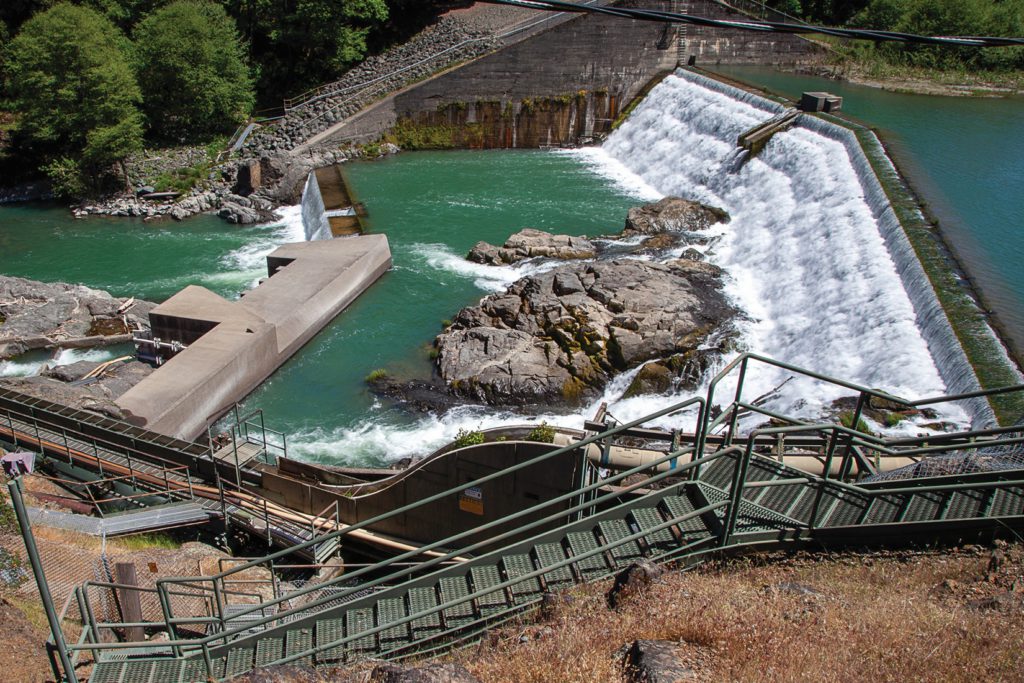At Potter Valley Rodeo this Memorial Day weekend, “The Star-Spangled Banner” echoed across the arena in Hannah Foster’s voice.
A tradition almost as old as her family’s six generations farming in this corner of rural Mendocino County. But beyond the pageantry, Foster is sounding the alarm: The water that sustains her tiny town—and several cities beyond—may be running dry, and hardly anyone downstream seems to notice.
For more than a century, hydroelectric dams have diverted water through the valley from the northward flowing Eel River’s watershed to the southerly Russian River’s east fork, where the two wind within a mile of each other near the Lake County border. The local ecology, economy and culture have adapted accordingly.
Now that the alteration is no longer profitable, Pacific Gas & Electric is looking to undo the diversion by removing the dams, with potentially devastating ramifications for the communities that have grown to depend on the water they store and divert.
“We built an entire economy in Mendocino, Sonoma and Marin counties based on this water,” Foster said. “A hundred years ago, we would’ve made a different choice potentially, but we live in the option we have.” She is using her experience from a decade of public relations work in Sacramento to raise awareness of the water situation through online activism and fundraising.
“I said, ‘I’m just gonna make some stupid hats, and make some stupid T-shirts, and do something to catch people’s attention.’ Because people were like, ‘They wouldn’t do that.’ And I was like, ‘No. You don’t understand. They’re doing it,’” Foster said.
The Potter Valley Project began in 1908 with the construction of Cape Horn Dam—the lower of two dams, which forms the Van Arsdale Reservoir and includes the now defunct powerhouse. Water from the Eel River is diverted there, sent through a mile-long tunnel beneath Ridgewood Summit and drops 1,000 feet into Potter Valley. From there, some flows into local irrigation canals, with the rest flowing into the east fork of the Russian River, helping to fill Lake Mendocino, about 65 miles north of Santa Rosa.
Scott Dam, built in 1922 about 12 miles upstream, flooded the old settlement of Gravely Valley and created Lake Pillsbury. The reservoir holds up to 75,000 acre-feet—about 24.5 billion gallons—roughly equal to the average annual diversion through Potter Valley since the system was built, about 7% of the Eel River’s flow.
In 2021, that volume was reduced to around 30,000 acre feet after PG&E’s main transformer failed and hydroelectric operations ceased, while Lake Pillsbury was reduced by 20,000 acre-feet due to a downgrade of Scott Dam’s seismic rating, both harbingers of what may be to come.
Veterinarian Rich Brazil has served Potter Valley’s ranchers for the past 37 years and sees the loss of that water as an existential threat to his community. “It’s gonna mean just the collapse of industry here. I deal with a lot of cattle and sheep. But also the pears and grapes, everything that requires irrigation, will go,” Brazil said, “and our fire risk is going to multiply.”
Potter Valley is beset on two sides by the scars of wildfire. Lake Pillsbury provides a rare and critical firefighting asset: a water source large and stable enough for fixed-wing aircraft to land and refill. During the 2017 Redwood Complex Fire and the 2018 Ranch Fire—one of the largest in California history—the reservoir proved invaluable, serving as both a tactical water source and a natural firebreak that helped prevent even greater devastation.
CalFire’s Mendocino battalion chief, Shane Lamkin, gave a diplomatic answer to enquiries about Lake Pillsbury’s significance as a fire fighting resource. “We have utilized Lake Pillsbury for fires within the area such as the August Complex and the Mendocino Complex. If the dam were to be removed, we would look to other resources nearby, such as the river, for a source to use for water supply,” Lamkin said via email. But airplanes can’t land on a shallow river like the Eel.
A coalition of considerable political force has aligned behind PG&E’s effort to relinquish its license for the Potter Valley Project. Environmental nonprofits, tribal representatives and elected officials, including Rep. Jared Huffman, have endorsed the removal of Scott Dam, citing seismic risk, fish habitat restoration and historical justice for the Round Valley Indian Tribes as core motivations.
PG&E argues that Scott Dam presents a long-term seismic hazard and is no longer economically viable to maintain. In a January filing with the Federal Energy Regulatory Commission, the company said it would not pursue relicensing due to “significant costs associated with seismic and safety upgrades.” This decision comes in the wake of multiple wildfire-related liabilities running into tens of billions of dollars.
But critics question the urgency of the risk. If the dam posed an imminent seismic threat, why does it still hold back more than 50,000 acre-feet of water? No emergency drawdown has been ordered, and the reservoir remains full to only slightly reduced capacity. As Foster put it: “They say it’s too dangerous to keep, but not dangerous enough to empty.”
Former congressional candidate Chris Coulombe sees the safety argument as a strategic cover. “I researched this before the campaign, and this dam doesn’t have any extra concern above any other dam in California,” Coulombe said. “This whole thing is being driven by political actors for political gain. Meanwhile, the community that will suffer most has never had a seat at the table.”
The dam and the affected stretch of the Eel River do not lie on Round Valley tribal lands, but the tribe asserts cultural and historic ties to the river system.
As part of a 2025 agreement, they are set to receive transferred water rights and financial compensation from downstream users for the 30,000 acre-feet they transfer a year, fueling speculation that financial and political incentives may be driving the narrative as much as ecological science or safety concerns. Potter Valley locals worry that this arrangement could mean their water will become prohibitively expensive, reduced in volume or even cut off during the times they need it most.
The argument for ecological restoration hinges on restoring fish passage, particularly for threatened Chinook salmon and steelhead. A 2020 NOAA-funded study identified up to 175 miles of potential steelhead habitat and 40–50 miles for Chinook salmon above Scott Dam, though full restoration would depend on addressing seasonal barriers and temperature issues. Locals familiar with the area believe the spawning grounds described in that report to be exaggerated, and represent a small fraction of the breeding habitat available in the Eel RIver.
Much less certain is the dam’s causal relationship to depleted fisheries. Former Mendocino County Supervisor Michael Delbar, who was involved in PG&E’s license amendment for Scott Dam during his tenure, said that in the face of overfishing, changing marine environments and overgrowth of an invasive pike minnow known to predate salmon and trout fry, that line is too complex to draw.
“We’re trying to solve a 90% problem with a 10% solution,” Delbar said. “For one tenth the cost of taking the dam down, you could build a fish passage and let the fish up there to do their thing. We spent more than that on the studies we’re doing.”
California Trout (CalTrout), the environmental non-profit partner in the Two Basin project, says Scott Dam presents unique challenges to conservation engineers. “Several designs of fish passage were researched and found to be technically difficult and very expensive,“ said Charlie Schneider, senior project manager for CalTrout. “Then you have to transport the juveniles below the dam, and it just gets very costly.” Though costly doesn’t mean impossible.
Even if removing Scott Dam clearly benefits the fish, as Schneider asserts it does, the 2025 appellate ruling in Bring Back the Kern v. City of Bakersfield reinforces that environmental mandates—like Fish and Game Code § 5937, which requires dams to release enough water to keep fish in good condition—must be weighed against other uses under California’s Constitution.
Article X, Section 2 mandates that all water use be “reasonable,” a standard that includes cities and farms. If residents of the Russian River Valley come to believe their water security is at risk, this precedent could support a legal argument that their needs warrant priority over a limited environmental gain.
The Two-Basin Solution, backed by PG&E’s coalition and Huffman, is projected to cost upwards of half a billion dollars, a modest estimate, with no clear funding plan. Add another $250 million earmarked to raise Coyote Valley Dam, a storage expansion made necessary by the proposed removal of Lake Pillsbury.
Advocates for the lake believe that, for the same amount of money, Scott Dam could be retrofitted for seismic resilience and a fish ladder built. But in California, capital flows more easily from affluent districts toward environmental initiatives than toward preserving infrastructure in forgotten rural valleys.
“The part they whisper under their breath is that [the proposed new diversion] will only be flowing for six months instead of 12,” Coulombe said. “The amount of water that goes through Potter Valley may be the same on an annual basis, but it will only be available for a six month window.”
Acknowledging these concerns, Sonoma Water officials say seasonal shifts can be managed through coordinated operations at Lake Mendocino and continued efficiency improvements. They maintain that water supply for Russian River communities will remain stable even without Lake Pillsbury.
Either way, upstream of Lake Mendocino and without Lake Pillsbury’s storage in the summer months, Potter Valley will only be getting water from the Eel River diversion when they need it least, and rural communities down river remain skeptical.
In April, the Lake, Mendocino, Sonoma and Marin County farm bureaus jointly sent a letter to President Donald Trump, urging federal intervention to halt PG&E’s plan to dismantle Scott Dam, and emphasized that the dam’s removal would threaten the region’s water accessibility, economic stability and disaster preparedness. The farm bureaus sought an urgent meeting with federal agencies to discuss intervention options before PG&E’s final decommissioning plan submission deadline on July 29, 2025.
The letter requested that the Bureau of Reclamation assume ownership of the project, a preferred outcome shared by Foster and many of her neighbors. “I would like to see the federal government take ownership of the dam,” Foster said. “The Army Corps of Engineers already operates Lake Mendocino. It would be amazing if those were two pieces of the same project.”
When California’s dams are gone, the chances of building new ones are next to zero. Even when funding is allocated for less controversial water storage—like the $2.7 billion set aside in the 2014 Water Quality, Supply, and Infrastructure Improvement Act—projects are often stalled or canceled by environmental review and permitting delays. Meanwhile, the specter of climate-driven drought grows more urgent.
This issue is being forced by the fiscal woes of PG&E—a fact even its Two Basin partners concede. Newly pressing concerns over seismic risk, fish passage and tribal justice are, at best, conveniently timed. Still, as a private utility, PG&E is within its rights to walk away, whatever the outcome.
So the fundamental question surrounding what happens now is whether water infrastructure should serve the public as a strategic asset, or be managed under a more transactional model shaped by regional and financial interests. PG&E will no longer pay to maintain the dam and diversion. No viable public partnership emerged to assume the liability.


